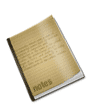 |
Recommended readingLim, H. & Iwama, M.K. 2006. Emerging models- An Asian perspective: The Kawa (River) Model. In Duncan, E.A.S. (ed). 2006. Foundations for practice in occupational Therapy. 4th Edition. Elsevier Limited: London. |
Introduction
The Kawa (River) model was developed by Japanese occupational therapists in the 1990s in response to a need for an occupational therapy framework that socially and culturally communicated their worldview of occupation and well-being. This model is a framework that embraces the issue of culture in occupational therapy. The model serves as a departure point from Western based models of practice that strongly value and strive for the clientís independence and autonomy in occupational performance. On the contrary, the Eastern perspective focuses more on collective shared interest and consensus between the client and the environment. For example, the self is seen not as an individual, but a part of a larger whole, which could be a community, the environment or family. This indicates that the individual according to this perspective is inextricably linked to the larger whole, therefore the actions and experiences of an individual cannot be separated from the whole.
The Kawa Model aims to provide a framework that would enable therapists and students to understand and be sensitive to the clientís circumstances in context. This would enable development and use of intervention strategies that are truly client-centered. Occupational therapy is faced with a challenge of having culturally relevant conceptual models and ideas about occupation or doing, as well as appropriate methods of delivery of therapy. Therefore, the Kawa model also presents an opportunity for critical reflection on occupational therapy frameworks and their applicability in diverse cultural settings. Occupations and occupational performance have different meanings to people from different spheres of life and who have different experiences or circumstances. Therefore, occupational therapists need frameworks that are conscious of cultural differences between the people that they serve, so as to plan intervention appropriately. Kawa means river (in Japanese) and the Kawa model uses it as a metaphor for life flow.
The central concept of the Kawa Model is harmony, which is described as a state of being, where the individual or community is in balance, which relates to the presence of coexistence and interdependence within the context that one is part of. The essence of the harmony is life flow. Wellbeing is characterized by a state in which all elements coexist in harmony within the context and disruption of harmony interferes with the coexistence or life flow. Therefore occupational therapy intervention would be focused on enabling the client to enhance balance in the life flow.
Structure and Components of the Kawa Model
Harmony between self and context in life is a complex dynamic in the Eastern perspective. Therefore a metaphor of a river was used to communicate the complexity. The river itself represents the life that flows through time and space. A state of well being is said to be portrayed by a strong unobstructed flow of the river. The flow could be affected by structures within the river that form inseparable part of the river and these represent environmental aspects and life circumstances. The following structures were identified, namely:
Occupation is metaphorically represented by the space between the obstructions in the river (sukima). These spaces are potential channels for life flow and in occupational therapy they provide an opportunity for both the therapist and the client to consider multiple focal points for intervention. Spaces represent opportunities for problem-solving. The spaces could relate to what matters to the client that is meaningful and important. A space between a rock and environment may represent a medical condition and important social roles.
Qualities of the Model
The Kawa model is unique in that it encourages the therapist to think and does not prescribe ways of addressing problems, but encourages exploration and discussion between the therapist and the client or community. This promotes a client-centered approach to intervention in which the clientís experiences and concerns are valued and the client is recognized as a partner and not a passive recipient of therapy. Lastly, the main aim of occupational therapy intervention according to the model is to enable and enhance life flow, whether interpreted at individual or at community level. It is important to keep in mind that the self is embedded in the context and is not a separate entity.
The complex dynamic that characterizes an Eastern perspective of harmony in life between self and context might be best explained through a familiar metaphor of nature. The river is employed as a symbol for the life course. It has its beginning at higher elevations and its termination somewhere, lower down along the course of time. Rivers can cease to flow by drying up, by being dammed by natural or man-made actions, by flowing into a terminal lake or into the vast sea. Wherever the river flows, the profound and complex inter-relation of other elements of nature become apparent. As other elements of nature participate in the life or flow of a river, so the river also participates in the other. Vital relationships form between all elements in a context/frame and a balance or 'harmony' comes into being. It is a balance that reflects the inter-related nature of the elements quite unlike the artificial, mechanical metaphor of the individual as a (mechanical) 'system' oriented to subdue and exert control over circumstance and an objectified environment.
 |
Case studies
|
References
Lim, H. & Iwama, M.K. 2006. Emerging models- An Asian perspective: The Kawa (River) Model. In Duncan, E.A.S. (ed). 2006. Foundations for practice in occupational Therapy. 4th Edition. Elsevier Limited: London.
For more information on the development and application of the Kawa (River) Model visit the website: www.kawamodel.com
















